Downtown>Hampton>IKEA>Downtown Part 2
Yesterday, in Part 1, I talked about the two different transit I’d taken (MetroLink, #90 & #32 MetroBus) and issues faced as a pedestrian trying to navigate in between. I’d made it to IKEA for shopping, followed by lunch.

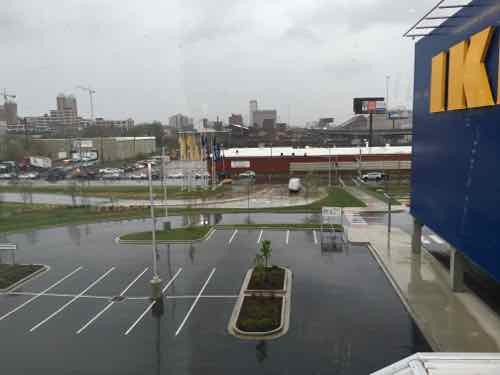
I checked the transit options, it would be a while before a MetroBus stopped out front. Plus, that would only get me to Lindell where I’d have to wait in the rain for the #10. The Grand MetroLink is closer than the CWE MetroLink, but Forest Park is the most direct route and I recall some access issues the last time. Plus, my transfer from earlier was now long expired.
No matter what I’d be in the rain, so I decided to just roll home — 2.9 miles. I’ve done it a few times before, though not in the rain. I’m still wearing a poncho to keep me and the controller on my chair dry. My shoes, however, get soaked. North on Vandeventer to Lindell. I stayed on the West side of Vandeventer because I’m bot sure if the city ever got around to the huge gaps in front of the curb ramps on the NE corner of Vandeventer & Forest Park. At Lindell, I checked the schedule again — I can get home before the next bus would arrive.
Because of the rain I only took a few pictures. The following week I took the bus to Lindell & Spring to backtrack and take pictures of things I saw in the rain.
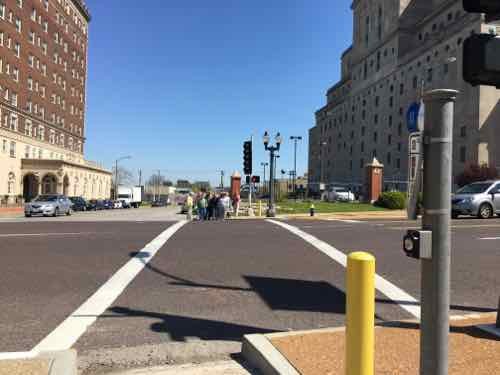
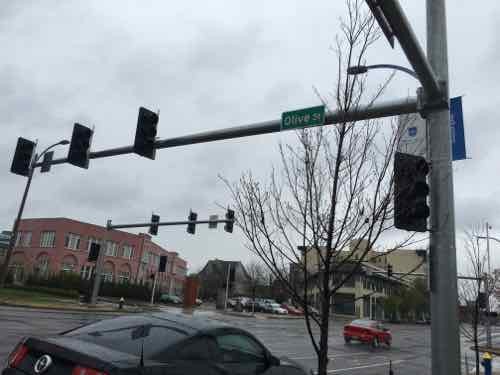
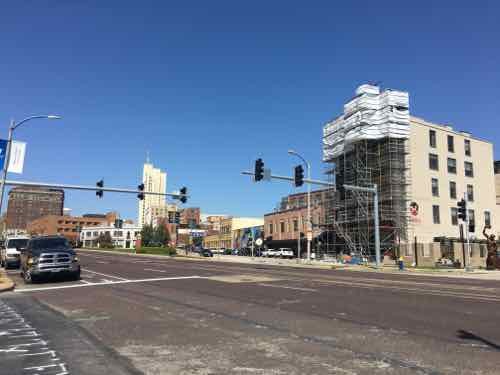
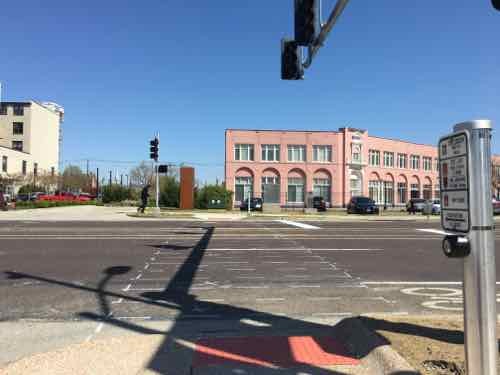
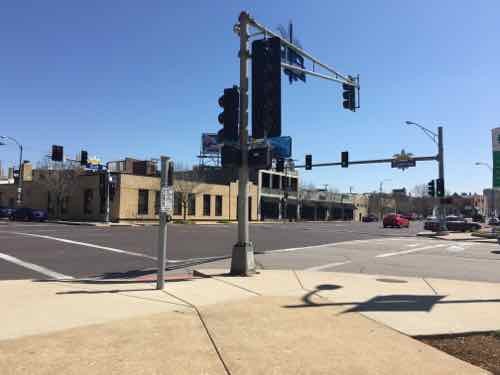
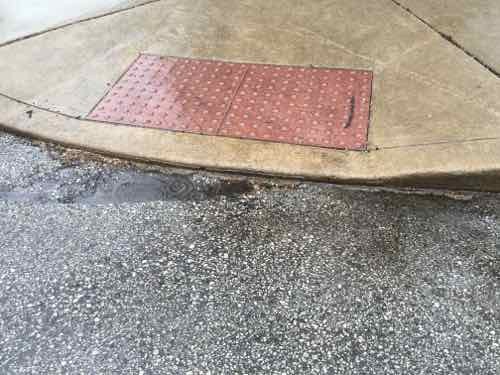
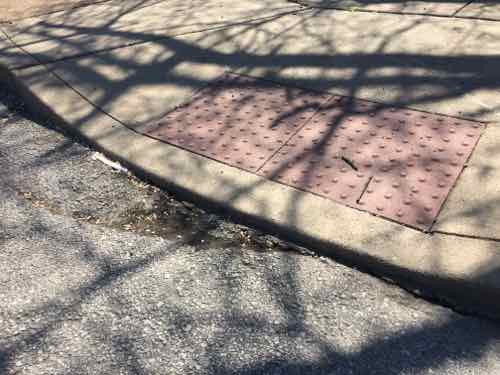
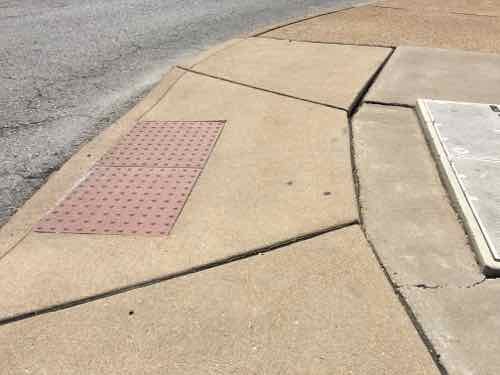
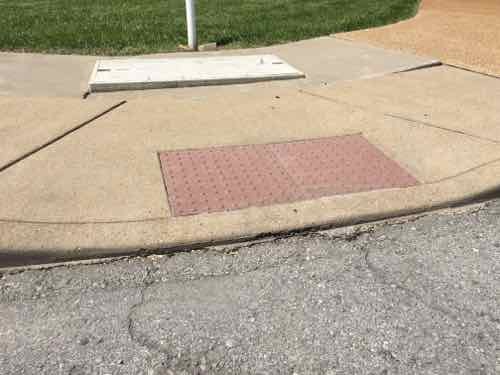
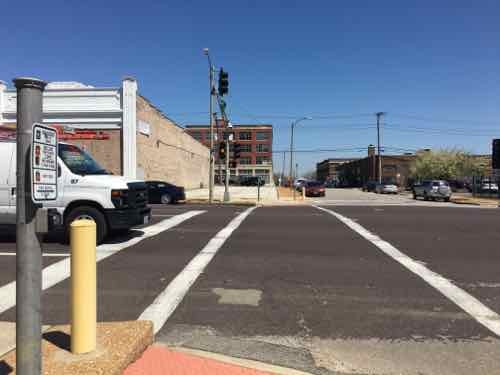
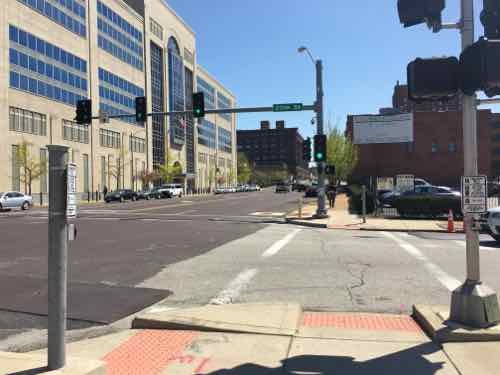
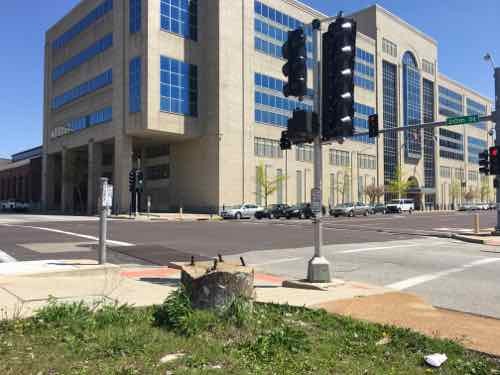
Used to be — but no curb ramp is missing for the nearly 3 mile trip. If I tried to use Locust there are many missing curb ramps.
I still fail to understand why all the cost of the buttons when they don’t need to be pushed in the East-West direction. And why have to press a button to get a walk signal when vehicles from side streets get a green light? This is how we’ve spent money — building infrastructure that frustrates this pedestrian!
— Steve Patterson
To answer your closing “why” question – pedestrians travel at slower speeds than vehicles, about 4.5 feet per second. If a pedestrian is crossing a 40′ wide street, it takes them about 9 seconds, a 60′ wide street takes 13.5 seconds and a 100′ wide street takes 23 seconds. If the cycle allows 20 seconds (or more) of green time for vehicles, there is adequate time to give peds a “walk” light on every cycle IF the street is less than 60′ wide. But, as is the case with Olive, the primary (E-W) street is both wider and carries more traffic, so the signal phase is biased toward E-W traffic. To give peds adequate time to cross in a N-S direction requires a longer green cycle than is required for “normal” vehicular traffic. A push button simply adds more time to the next N-S cycle (based on actual ped demand), while maintaining a shorter green cycle when the button is NOT activated (which is MOST of the time) to better match the unequal vehicular (N-S vs E-W) demands: http://nacto.org/publication/urban-street-design-guide/intersection-design-elements/traffic-signals/signal-cycle-lengths/
I’m quite familiar with walking speeds and distances. The speed of my chair is considerably faster than most able-bodied folks walk normally.
I’m guessing you haven’t checked the timing of these signals. Like many in the city, three’s sufficient time to cross — they just give priority to cars.
We have some intersections where pedestrians do get a walk signal but it returns to stop while cars have a green for another 20-30 seconds.
I’ll go back soon to time one of these to see how it is set up. Most likely pressing tabs button doesn’t change the traffic signal timing — my guess is it just activates the walk signal. Need to verify — but would be highly surprised if otherwise.
One, the city does not time ped signals for people in power chairs, they time them for “normal” people, and there’s now pressure to time them to give peds even more time, to compensate for the slower pace of the growing number of elderly people. Two, yes, the city does give priority to cars, because, duh, there are more cars going thru most intersections most of the time. And, three, the reason why when “pedestrians do get a walk signal but it returns to stop while cars have a green for another 20-30 seconds”, is that there is no yellow light for peds – the ped signal turns to “don’t walk” when there is not enough time for peds to START to cross at a “normal” pace; it does NOT mean that peds have to vacate the crosswalk, immediately, if they’ve already started to cross – it’s that old time-space continuum thing!
You’re wrong!
1. The timing on the ped signals is largely random from signal to signal, but far from enough time for regular folks. Some are barely enough for my chair on the highest speed!
2. More pedestrian-friendly cities, like Chicago, do not design the city to discourage pedestrians.
3. I’m at Leffingwell & Olive right now, I just timed the lights with and without pressing the ped button. The signal on Olive gets 90 seconds regardless if someone wants to cross. Workers coming to Wells Fargo don’t bother with the button, or even waiting on the light. The Leffingwell light is 37 seconds, regardless of the ped button. When pressed the ped button begins a countdown after 7 seconds. There are a few seconds of don’t walk before the light changes to yellow, then red.
4. There are signals that after the ped says don’t walk I still know I can cross before the light changes. Others, the light changes immediately.
So, there are obviously both timing and maintenance issues. That doesn’t change the basic thinking, that crossing wider streets takes more time!
Remember, too, that many of the issues with pedestrian signals, in the city, just like with vehicular signals, is a huge lack of money. The city continues to patch together what it has, since it doesn’t have the resources to do the latest and greatest, interconnected system, with countdown timers on every corner. Yes, we can all dream, but I’d rather focus on the art of the possible.
And, I’ll repeat, it doesn’t matter how good or bad the signal on the corner may be IF you can’t traverse from one corner to the next! Given our limited resources, I’d much rather see the city focus on connecting the missing links than investing in better signals – it’s all about making some hard choices . . .
My timing results were accurate, but in my lunch yesterday with bike/ped coordinator Jamie Wilson I learned this intersection MAY have vehicle detection (in road or camera) to activate the Leffingwell signal only when a car is present. He is going to confirm for me.
The good thing about vehicle detection is it doesn’t stop traffic on the main road unless necessary. The downside is it might not detect cyclists and requires pedestrians to press a button. Remember, not everyone can physically press a button. Some have visual impairment so finding a button can be difficult, others don’t have the dexterity.
The able-bodied people I saw crossing yesterday just don’t care if they have a walk signal or not — they’re not going to bother.
I agree, most pedestrians don’t pay a lot of attention to ped signals (nor do a lot of drivers). The real challenge remains detection / activation. A vehicle is far easier to “monitor” (and respond to) than humans ever will be – see self-driving cars!
Actually, new technology is making automatic pedestrian detection possible.
I agree that it’s “possible”, the question is at what cost. Ten-plus years ago I was aware of efforts to add “smart” detection to video monitoring systems, so that people watching banks of security monitors would be less likely to miss criminal activities (out of sheer boredom). Back then, both false positives and missed detections were happening far more than were acceptable. Even today, most video systems are used reactively, to try and identify a criminal after the fact, instead of proactively, to allow police to respond as the act is occurring. The same issues remain for pedestrian detection – you want the “system” to recognize pedestrians, but not to respond to vehicles, dogs, birds or rodents . . .
Why are you such a car slave?
What is amazing, aside from the fact it is so hard to get around in a wheelchair, is how basically unattractive the walking environment is for encouraging pedestrians. In fact one of the biggest problems of St. Louis as it has evolved is that the pedestrian experience is completely ignored. Generally the only areas of St. Louis that have a consistent and attractive pedestrian experience are the old neighborhoods.
Just like this little girl killed in Ballwin a few days ago, pedestrians are marginalized when it comes to design. Unfortunately the bad practices of the county are being applied to the city. What was really amazing about that incident was MoDot in response said there were no sidewalks in the area when they last reviewed it so they felt no need to accommodate pedestrians. This is across from a school no less. It is indicative of the who the hell cares attitude by too many in position to do something about the pedestrian experience and safety.
What happened in Ballwin could have (and has, repeatedly) happened just as easily in the city. Inattentive, distracted driving is NOT exclusively a suburban issue.
It is more than just distracted driving or distracted walking we are speaking about here. I find it remarkable MoDot didn’t put up at a minimum a pedestrian activated crossing at this school. They should know kids will walk in the grass. I am willing to bet if such an crossing was in place the girl they died would have likely used it.
There are many other traffic calming, pedestrian enhancement design possibilities to help make pedestrians equal partners with the auto.
Steves two posts on this subject illustrates the disregard for pedestrians and for the disabled. The city is importing the worse of the county.
18 pedestrian fatalities in the city, 10 in the county, based on the most recent statistics: http://www.stltoday.com/news/traffic/along-for-the-ride/rising-number-of-pedestrian-deaths-has-st-louis-officials-concerned/article_3247371b-202d-5310-b6ee-3f0991732822.html . . . the problem in Ballwin was that it was a special event, with a huge increase in the number people (parents) driving and parking, thus the need for overflow parking, and thus the need to cross the road in a place where pedestrians rarely cross. This was also a case of a driver turning left, out of a driveway, likely looking right, and, in the name of improved safety, having a fat A pillar, between the windshield and the door, big enough to hide pedestrians from view. Are they all lame “excuses”? Absolutely! But, I’ll repeat – this has far more to do with vehicles and drivers, and NOT urban vs. suburban design!
So you’re saying that a marked cross walk with a pedestrian activated light wouldn’t have possibly saved that little girls life?
By your logic the region can do away with all of the pedestrian cross walks and lights because pedestrian fatalities have far more to do with vehicles than urban design.
I get it, you prefer an urban environment exclusively designed for cars rather than actual human beings.
There is a large body of literature on designing for the pedestrian if facts are part of the discussion.
Yes, design matters, consideration of the pedestrian creates safer, more attractive environments that are the foundation of great cities.
Trying to explain away what happened in Ballwin while failing to acknowledge how the poor design of the area contributed to the death is like treating her as collateral damage for the self interest of the automobile.
The role of urban planning should become a major point of discussion and not merely tossed aside in silence as bad driving, which is what you seem to want to do.
Putting in a “marked cross walk with a pedestrian activated light” makes sense where there is daily pedestrian activity, not someplace where special events happen 2-3 times a year. I’m guessing that the driver who hit the pedestrians was leaving the same event, so they knew, or should have known, that they had to take extra precautions due to the number of pedestrians present (no different than the heavy pedestrian activity around a Cards game, Fair St. Louis or Mardi Gras). Personal responsibility continues to be minimized / ignored, since it’s way easier to blame someone else than to accept responsibility for our actions!
Maybe you should try asking the parents of the dead girl what the value of a pedestrian light would be in this location?
And please stop with the personal responsibility crap, it is a 7 year old girl we are talking about.
The irony is that you are the one without personal responsibility and accountability, Society has an obligation to children, and to all, to provide the safest, most user friendly environment possible That is what Steve’s post is about as he describes failures to make the environment universally accessible.
As a member of society you shun that responsibility and blame anyone who dares question whether the right actions are being undertaken to protect the interests of all, not just car owners.
I understand you are supposed to be an architect, you must of fell asleep during design classes, you don’t seem to have a clue about how design can improve peoples lives.
You have interesting viewpoints now and then, but your incessant attempts to kill conversation about how to improve the human condition makes discussing anything with you pointless.
I am particularly disgusted that even with a 7 year old dying, you still maintain your holier than thou, I’m better than everyone else position.
“The personal responsibility crap” was directed at the driver who “did not see” and, to a lesser degree, the father who was crossing the road at the same time, not at the seven year old! Every design assumes a certain set of rules and some pedictable human behavior. When people operate outside those known boundaries, bad things can, and sometimes do, happen. See people falling over the sides of escalators. See people driving the wrong way on a freeway. See any Darwin award winner. Yes, we could put up a pedestrian crossing light every quarter mile in the suburbs. Guess what? People will continue to get hit, because drivers will continue to ignore signals and pedestrians will continue to walk or run in front of moving vehicles. We all drive in an imperfect world. Yes, a light or a police officer “might” have helped, here, but it was the DRIVER who failed to SEE two (and likely more) pedestrians before hitting them! The DRIVER was leaving the same event. The DRIVER was RESPONSIBLE for (not) CONTROLLING their vehicle and for hitting the two pedestrians!
You don’t get it do you? This is not about a moralizing, self righteous rant. It is about about responsible adults, leaders in Ballwin, St. Louis County and MoDot asking what can we do better? What is wrong in this situation? How do we prevent these types of accidents happening? Not only this one, but trying to address pedestrian concerns throughout the region.
MoDot at a minimum should send a memo to muni’s along highways they maintain questioning whether or not it would be better to put elementary schools on secondary roads. This is along the lines of more traditional planning, say old St Louis.
And if an elementary school is necessary on such a road, address the issues: sidewalks, pedestrian crosswalks, nearby driveways, stop signs, traffic lights, speed limits and so on, in other words find solutions for creating a safe and user friendly pedestrian environment.
Finding solutions is far different than barking out ideological claptrap.